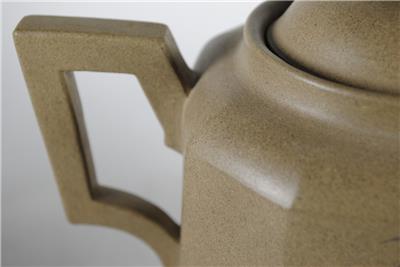Youzi wrote: ↑Wed Nov 06, 2019 3:48 am
The only way to know if a pot is made of a specific sub clay type is to see the raw ore of which it was processed, know the mesh size, know how it was processed, know the exact firing temperature, and know that no reduction firing was going on.
So basically track down the rock, and make a private order from a Potter to process that ore for you and make a teapot out of it, based on your specification. Then you'd have a benchmark to compare to.
What I think would be tremendously helpful is to be able to buy firing discs.
Commenting on the picture, are you sure it is pure Benshan Lüni? Maybe it's the lighting, or it was partly reduction fired, but 90% of Benshan Lüni has a shade of Beige, light yellowish, or whiteish color. Then some more rare kinds, especially from Baoshan, can have more black spots and and be orangeish, reddish color.
Is that pot low or high fired? Seems more similar to Qing Duan Ni (青段泥) with good patina? Or could also be a Lüni mixed with other clays, since Lüni is notoriously difficult to fire properly.
Could you share more pictures of the inside and outside? Maybe the lid, as I guess it is less stained?
Hi Youzi. According to your criteria, it is impossible to know if a pot is made of Li Pi Ni. If this is a clay that was used during Ming and Qing, we don't know the information you state ("the raw ore of which it was processed, know the mesh size, know how it was processed, know the exact firing temperature, and know that no reduction firing was going on.") Even if we knew that information for a modern pot, we still could not know if an old pot is made of Li Pi Ni. But since Li Pi Ni is defined based on its use during Ming and Qing, there is no way to tell if a modern pot is made by the same "Li Pi Ni" that was used in those times.
Regarding the pot I posted, of course I am sure it's Ben Shan Lv Ni. The problem is that most modern "BSLN" is very yellow, so there's the expectation that BSLN is supposed to be canary yellow.
Older, top quality BSLN has a whiter, more transparent and quartz/like appearance, as you can see in this Qing example posted by chrl42:
http://teadrunk.org/post/963/#p963
It is obviously not Qing Duan Ni (青段泥), the grain and texture of Qing Duan Ni is much coarser, Qing Duan Ni does not have the yellow/green hue that this pot has. Here is another picture:

- 1020740762_tp.jpg (11.62 KiB) Viewed 49868 times
It's this jade-like quality that made BSLN so sought after. So regardless of where it's from, a modern BSLN pot that's canary yellow and lacks the quartz like appearance is not really displaying what BSLN is about.
